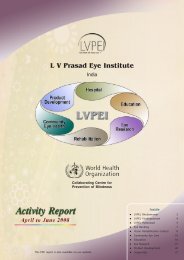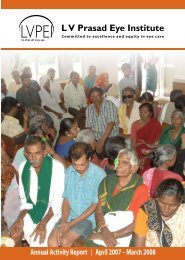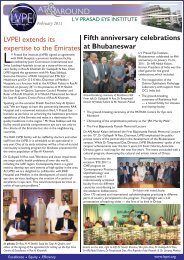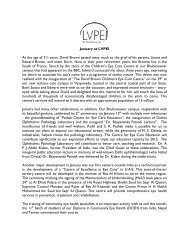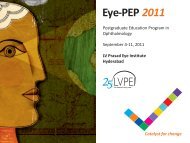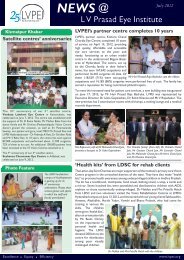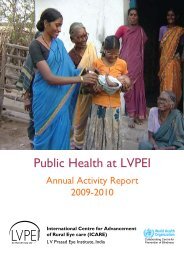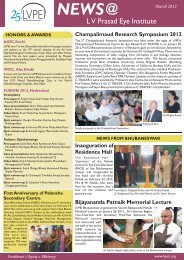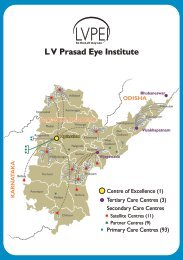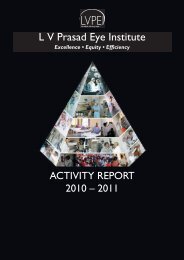Glimpses 2009-2010.pdf - LV Prasad Eye Institute
Glimpses 2009-2010.pdf - LV Prasad Eye Institute
Glimpses 2009-2010.pdf - LV Prasad Eye Institute
Create successful ePaper yourself
Turn your PDF publications into a flip-book with our unique Google optimized e-Paper software.
the Herpes Simplex Virus-1 (HSV), Varicella Zoster Virus (VZV) and Cytomegalovirus (CMV), which<br />
can be used quite conveniently in patients with ocular infections at secondary and primary health<br />
care facilities. The LAMP assay is a simple molecular diagnostic tool, in which the reaction takes place<br />
in a single tube that contains buffer as well as target DNA, Bst DNA polymerase and primers. The<br />
tube containing this reaction mixture is incubated at 650C in a regular laboratory water bath or heat<br />
block that maintains a constant temperature. This overcomes the need for a thermal cycler because<br />
the entire amplification cycle can be achieved at a constant temperature. The technique does not<br />
require the more expensive components of the original test. The final amplified product in the LAMP<br />
is detected by unaided visual examination by adding SYBR green dye to the reaction tube. The initial<br />
findings using this test in patients with retinitis have been promising.<br />
G Ashok Kumar Reddy<br />
Jhaveri Microbiology Centre<br />
Saroja A Rao Immunology Laboratory<br />
How does vision develop in infants<br />
The newest addition to the Prof Brien Holden <strong>Eye</strong> Research Centre is the Visual Optics and Psychophysics<br />
Laboratory, headed by Dr Shrikant Bharadwaj. Research conducted in this lab seeks to understand<br />
how infants, children and adults use their focusing and eye-alignment responses to achieve clear and<br />
single vision of their world and why some individuals develop abnormalities like eye-turn and lazy eye,<br />
while other age-matched controls do not. With help from his former colleague, Prof T Rowan Candy<br />
of the Indiana University School of Optometry, Dr Bharadwaj has put together equipment that will<br />
enable non-invasive investigations on very young children. Dr Bharadwaj intends to study the focusing<br />
and eye-alignment responses of both typically developing infants and children and those children with<br />
visual abnormalities. The responses of these children will be interpreted using computational models<br />
of how the visual system uses various sensory clues to achieve and maintain simultaneous clear and<br />
single vision. The laboratory will engage individuals with a clinical and/or a basic science background to<br />
participate in its various research activities. Optometry and ophthalmology students and fellows will<br />
have an opportunity to participate in short or long term projects in this laboratory.<br />
Excellence Equity Efficiency Page<br />
37<br />
F_Inside_Pgs.indd 37<br />
9/2/2010 12:33:12 PM



